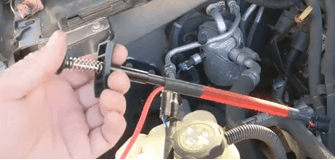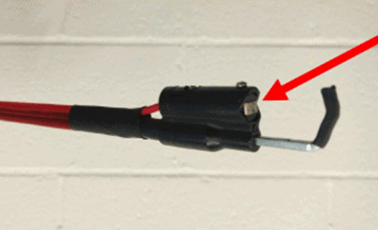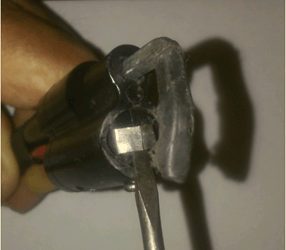Tips for taking your mobile A/C system’s temperature
By Richard Hawkins, MACS contributor
In last week’s blog post, we illustrated why the accuracy of contact type temperature thermometers made them superior to infrared temperature guns for doing mobile air conditioning diagnostic work. The contact type units do indeed have a high degree of accuracy, but precautions must be taken when using them (especially connecting to lines) to ensure the accuracy. Otherwise, it is possible to get readings that are easily 5° to 10° off and that can lead to an incorrect diagnosis.
To understand how this is possible, first we need to look at how the connectors are designed. The units used in the MACS Update Clinic on March 30th have two long flexible connectors which allow access to hard-to-get-to places. At the top of the connectors is a depressor which is thumb controlled and has a spring which pushes it upward.
Please see picture # 1 below:

At the bottom is a hard piece of plastic which is about 3/4 of an inch wide.
A flexible cable connects the depressor to a small steel rod at the bottom which protrudes through the piece of plastic. The steel rod is bent into an L-shaped hook with a slight curve in it.
To attach to an A/C line, the thumb is used to move the depressor downward and the L-shaped hook is attached under the line. The depressor is then released, and the hook secures the line tightly against a slightly circular area which is cut into the piece of plastic. In this area of the piece of plastic is a small sliver of metal which is the sensing element.
Please see picture # 2 below:

The sensing element must have good contact with the line, otherwise an inaccurate temperature reading will result. This means that the lines being tested must be cleaned of any grease and grime before the connection is being made. Also, if a line is painted, it is best to take a piece of emery cloth and remove the paint in the area where the connection is being made to insure a good connection.
Sometimes the sensing element can get pushed inward a bit and it will not make good contact with an A/C line it is clamped to. When that occurs, it is necessary to take something that is flat and get under the sensing element and carefully raise it ever so slightly to get it positioned to make proper contact with the A/C line.
Please see picture # 3 below:

These contact temperature thermometers are precision tools, and it takes a bit of practice to achieve a comfort level in using them. It sort of reminds me a bit of when I first started using micrometers and dial indicator calipers years ago when working on engines.
Check back in next week, and we will cover some more tips on using them.
MACS members receive great mobile A/C repair information, join MACS as a member to get more great information like this!

Leave a Reply